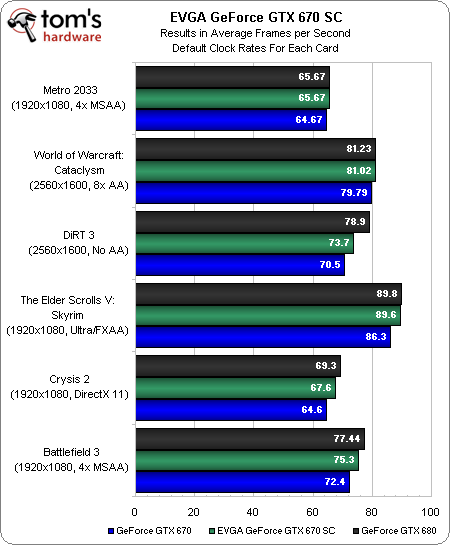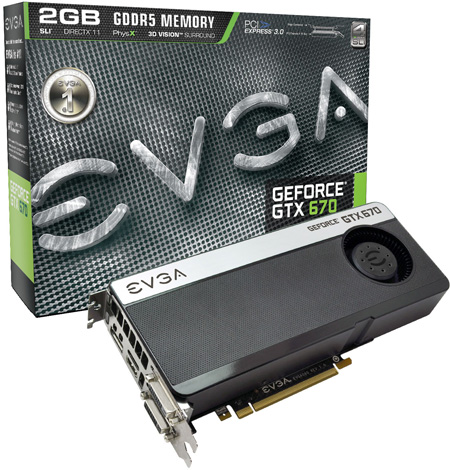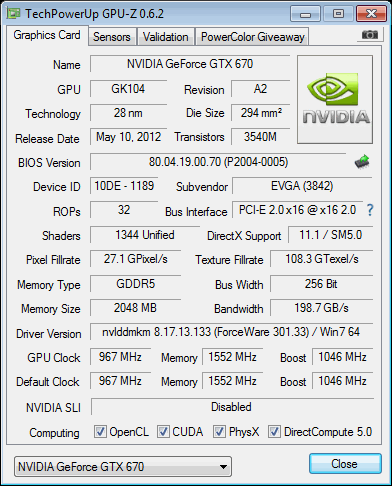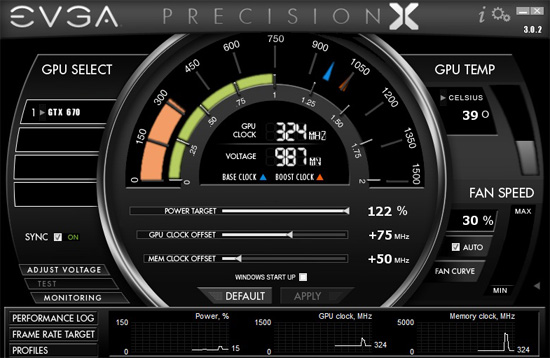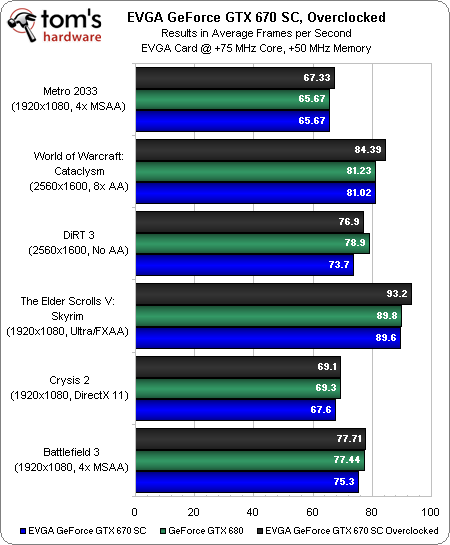GeForce GTX 670 2 GB Review: Is It Already Time To Forget GTX 680?
Not like it was ever really widely available anyway, right? The GeForce GTX 670 offers most of GK104's on-chip resources, doesn't give up much performance, and costs $100 less. Now, let's see if Nvidia can make enough of them to satisfy demand.
EVGA GeForce GTX 670 Superclocked
Although Nvidia is making its GTX 670 reference design available to add-in board partners, it expects to see a number of custom implementations right out of the gate as well.
EVGA sent us its GeForce GTX 670 Superclocked, which actually employs the same reference dual-slot form factor, but features elevated core (967 MHz), GPU Boost (1046 MHz), and memory (6210 MT/s) frequencies.
At its stock clocks, EVGA’s board offers a nice little performance bump. You can expect to pay $420 for that boosted model—a $20 premium. Many enthusiast won’t be willing to spend the extra money, since the Superclocked card’s overclock is probably well within the reach of manual tweaking. However, the security of EVGA’s three-year warranty on a factory-overclocked component will undoubtedly satisfy risk-adverse gamers who don’t want to bother tweaking on their own.
Interestingly, though, EVGA has a couple of other SKUs planned: a $470 GeForce GTX 670 4 GB and a $490 GeForce GTX 670 4 GB Superclocked.
We know a number of other vendors also have 4 GB models in the works, and the picture of the back of the GeForce GTX 670 PCB on the previous page makes it clear that there are pads on Nvidia's design just waiting for more memory.
Notice that the PCI Express bus is still running at second-gen transfer rates. The same X79-based issue that kept Nvidia from enabling PCIe 3.0 on the GeForce GTX 680 affects the 670, too. For a more thorough explanation (or at least, a more direct hint, I should say), check out page three of GeForce GTX 690 Review: Testing Nvidia's Sexiest Graphics Card.
Overclocking
Get Tom's Hardware's best news and in-depth reviews, straight to your inbox.
Of course, enthusiasts who are willing to get their hands dirty can take the GeForce GTX 670 Superclocked and apply EVGA’s superb Precision X utility to it. The recently-updated software facilitates manipulation of Nvidia’s power target, GPU and memory clock offsets, the card’s voltage, and fan speeds. Built-in monitoring makes it easy to keep tabs on power as a percent of rated TDP, clock rate (affected by GPU Boost), and several other variables.
We were able to take the already-overclocked EVGA even higher with a +75 MHz GPU offset and a +50 MHz memory offset, aided by a +22% power target, taking the board power up to about 173 W. At those frequencies, Precision X was reporting core clocks up to 1228 MHz and memory data rates of up to 6302 MT/s.
In most applications, the overclocked EVGA card is able to edge out a stock GeForce GTX 680. In just a couple, the 670 lands in between EVGA's stock clocks and the pricier single-GPU flagship.
All GeForce GTX 670 results in the following pages were generated using a card supplied by Nvidia operating at stock clock rates (915/1502 MHz). EVGA's GeForce GTX 670 Superclocked was only used for the benchmarks on this page. Our SLI results were generated by down-clocking the EVGA board to match Nvidia's.
Current page: EVGA GeForce GTX 670 Superclocked
Prev Page Giving GK104 A Haircut Next Page Test Setup And Benchmarks-
tecmo34 Great Review Chris!!Reply
Though there isn't really a performance hit but it would be great to have seen the GTX 670 running at PCIe 3.0. -
master9716 OMFG no 5760x1080 benchmarks again?!! ima have to go to hardware.info or something wow!Reply -
gilgamex101 "Dude.......seriously!?........you sure?.......wait wait, what about image qual--.....no......looks fine.........awwww.......AWWWWWWW !@#$......!@#$.........!@#$ !^&* *&^%$#@!@.....and you !$%^*(......green peice of !@#$%............GREAT.......JUST BEAUTIFUL.....- AMD in response to 670 GTX reviewsReply -
rglaredo I hate Nvidia and their supply and demand game ...it is obvious that they are just holding off the cards to inflate the prices...I'm going with AMD ....because I'm tired of waiting ...I'm not going to wait anymore ..Reply -
sayantan Nice move nV , forcing AMD to drop their prices for entire lineup. A 7970 at $400 would be really awesome...Reply -
godfather666 The list of games is very unfair to AMD cards. Techpowerup's review, which featured a much longer list of games, had the Radeon HD 7970 faster than the GTX 670 at all resolutions 1080p and higher.Reply
Nvidia has had a big lead in Dirt 3 and WoW for a very long time. This skews the results.
The GTX 670 is a fantastic card, don't get me wrong. Just pointing out that it's being slightly overrated here.
